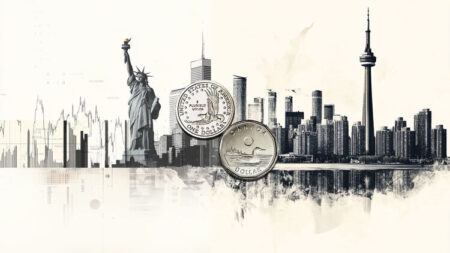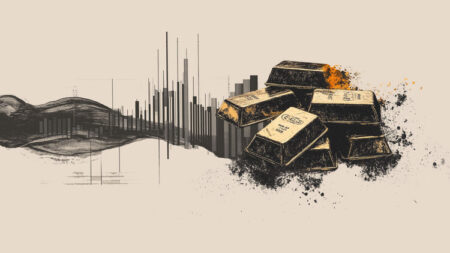- The core Personal Consumption Expenditures Price Index is expected to rise 0.1% MoM and 2.5% YoY in April.
- Markets expect the Federal Reserve to hold the policy setting unchanged in June.
- Annual PCE inflation is forecast to edge lower to 2.2%.
The United States (US) Bureau of Economic Analysis (BEA) is set to release the Personal Consumption Expenditures (PCE) Price Index data for April on Friday at 12:30 GMT. This index is the Federal Reserve’s (Fed) preferred measure of inflation.
The core PCE Price Index, which excludes volatile food and energy prices, is projected to rise 0.1% on a monthly basis in April, after remaining unchanged in March. Over the last twelve months, the core PCE inflation is forecast to edge lower to 2.5% from 2.6%. Meanwhile, the headline annual PCE inflation is seen retreating to 2.2% from 2.3% in this period.
Anticipating the PCE: Insights into the Fed’s key inflation metric
PCE inflation data is usually seen as a big market mover because it is taken into account by Fed officials when deciding on the next policy move. During the press conference following the May meeting, Fed Chairman Jerome Powell noted that inflation remains above their target and added that they expect upward pressure to persist. Citing “a great deal of uncertainty about tariffs,” Powell argued that the right thing for them to do is to await further clarity before taking the next policy step.
Previewing the PCE inflation report, TD Securities said: “We look for core PCE prices to remain subdued in April, rising 0.1% m/m after printing flat in March—though last month’s data will be revised higher. Headline PCE inflation should also come in soft at 0.06%. On a y/y basis, we look for core PCE inflation to rise 2.6%. We also expect personal spending to mean-revert after front-loading led to a 0.7% m/m surge in March.”
New York Fed President John Williams said earlier in the week that he wants to avoid inflation becoming highly persistent because that could become permanent. Meanwhile, Minneapolis Fed President Neel Kashkari noted that he supports maintaining interest rates until there is some more clarity on the impact of higher tariffs on inflation.
Economic Indicator
Personal Consumption Expenditures – Price Index (MoM)
The Personal Consumption Expenditures (PCE), released by the US Bureau of Economic Analysis on a monthly basis, measures the changes in the prices of goods and services purchased by consumers in the United States (US).. The MoM figure compares prices in the reference month to the previous month. Price changes may cause consumers to switch from buying one good to another and the PCE Deflator can account for such substitutions. This makes it the preferred measure of inflation for the Federal Reserve. Generally speaking, a high reading is bullish for the US Dollar (USD), while a low reading is bearish.
Read more.
How will the Personal Consumption Expenditures Price Index affect EUR/USD?
Market participants are likely to react to an unexpected reading in the monthly core PCE Price Index, which is not distorted by base effects. A print of 0.3% or higher MoM could support the US Dollar (USD) with an immediate reaction. On the other hand, a reading of 0% or a negative print could have the opposite effect on the USD’s performance against its major rivals.
According to the CME FedWatch Tool, markets currently see virtually no chance of a Fed rate cut in June, while pricing in about a 25% probability of a cut in July. Hence, the market positioning suggests that the USD has some room left on the upside if the monthly core PCE reading surprises to the upside. Conversely, investors could reassess the probability of a rate reduction in July if a soft PCE figure eases concerns that inflation remains sticky.
Eren Sengezer, European Session Lead Analyst at FXStreet, shares a brief technical outlook for EUR/USD:
“The Relative Strength Index (RSI) indicator on the daily chart holds slightly above 50, and EUR/USD fluctuates above the 20-day Simple Moving Average (SMA), reflecting a lack of seller interest. On the downside, 1.1200 (Fibonacci 23.6% retracement of the January-April uptrend, lower limit of the ascending regression channel) aligns as first support before 1.1015-1.1000 (Fibonacci 38.2% retracement, round level).”
“Looking north, resistance levels could be spotted at 1.1400 (static level), 1.1500 (static level, round level) and 1.1575 (April 21 high).”
Fed FAQs
Monetary policy in the US is shaped by the Federal Reserve (Fed). The Fed has two mandates: to achieve price stability and foster full employment. Its primary tool to achieve these goals is by adjusting interest rates.
When prices are rising too quickly and inflation is above the Fed’s 2% target, it raises interest rates, increasing borrowing costs throughout the economy. This results in a stronger US Dollar (USD) as it makes the US a more attractive place for international investors to park their money.
When inflation falls below 2% or the Unemployment Rate is too high, the Fed may lower interest rates to encourage borrowing, which weighs on the Greenback.
The Federal Reserve (Fed) holds eight policy meetings a year, where the Federal Open Market Committee (FOMC) assesses economic conditions and makes monetary policy decisions.
The FOMC is attended by twelve Fed officials – the seven members of the Board of Governors, the president of the Federal Reserve Bank of New York, and four of the remaining eleven regional Reserve Bank presidents, who serve one-year terms on a rotating basis.
In extreme situations, the Federal Reserve may resort to a policy named Quantitative Easing (QE). QE is the process by which the Fed substantially increases the flow of credit in a stuck financial system.
It is a non-standard policy measure used during crises or when inflation is extremely low. It was the Fed’s weapon of choice during the Great Financial Crisis in 2008. It involves the Fed printing more Dollars and using them to buy high grade bonds from financial institutions. QE usually weakens the US Dollar.
Quantitative tightening (QT) is the reverse process of QE, whereby the Federal Reserve stops buying bonds from financial institutions and does not reinvest the principal from the bonds it holds maturing, to purchase new bonds. It is usually positive for the value of the US Dollar.
Read the full article here
















